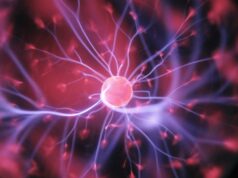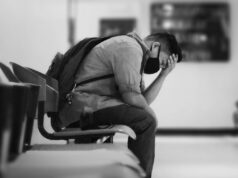
Stanford accelerated intelligent neuromodulation therapy (SAINT)—a novel, high-dose intermittent theta-burst stimulation (iTBS)—was found to be safe and more effective than sham stimulation in a recent randomised controlled trial (RCT). And, according to Nolan Williams, assistant professor within the Department of Psychiatry and Behavioral Sciences at Stanford University Medical Center in Stanford, USA, this technology has the potential to be a “gamechanger” for patients with major, treatment-resistant depression.
“The clinical results from our study were significant and rapid,” Williams, who also founded the Stanford Brain Stimulation Lab and, as such, played a key role in developing SAINT, told NeuroNews. “After five days of treatment, 79% of people experienced remission, meaning they were no longer experiencing symptoms of depression or suicidal ideation. Some patients found the treatment to be life-changing.
“Depression is the leading contributor to disability and an estimated 19 million Americans suffer from major depression. Conventional treatments for intractable depression take weeks or even months to begin working, and provide remission from depression for only a fraction of people. SAINT treatments are completed in five days or less and could help people return to their daily lives more quickly.”
Williams and his colleagues have published the results of the RCT in The American Journal of Psychiatry. In their report, they note initially that iTBS is approved by the US Food and Drug Administration (FDA) in treatment-resistant depression but is also limited by suboptimal efficacy and a six-week duration, with SAINT—a high-dose, accelerated repetitive transcranial magnetic stimulation (rTMS) protocol—being developed to overcome these limitations.
The authors also report that open-label trials of SAINT have shown a remission rate of roughly 90%, even in treatment-resistant patients—almost double the remission rate of around 48% with electroconvulsive therapy (ECT), which is the current gold standard in treatment-resistant depression. However, they add, this is the first time the efficacy of SAINT has been investigated in a double-blinded, sham-controlled trial to determine the contribution of the placebo effect.
The study was carried out from March 2017 to December 2019. A total of 182 patients who had a primary diagnosis of major depressive disorder, were currently experiencing a moderate-to-severe depressive episode, and had moderate-to-severe levels of treatment resistance, underwent eligibility screening, the authors report, with 29 patients ultimately being enrolled and undergoing 1:1 randomisation to receive either active SAINT or an identical course of sham stimulation.
Ten sessions of active or sham iTBS were delivered daily to personalised targets in each patient’s brain on five consecutive days. The study’s a priori primary outcome was Montgomery-Åsberg Depression Rating Scale (MADRS) score four weeks after the end of this five-day SAINT protocol, with response being defined as a ≥50% reduction from baseline in MADRS score and remission being defined as a MADRS score of ≤10%.
Reporting the results, the authors note that, across the four-week follow-up, 12 of 14 patients (85.7%) in the active SAINT group met the criterion for response and 11 (78.6%) met the remission criterion in at least one of the five post-treatment assessments. In the sham treatment group, four of 15 patients (26.7%) responded and two (13.3%) remitted at some point during the four-week follow-up. They further state that patients in the active treatment group showed significantly greater post-treatment reductions in MADRS scores at all follow-up timepoints (zero, one, two, three and four weeks) and equivalent results were found for secondary outcomes—score changes on the six- and 17-item Hamilton depression rating scales (HAM-D), and the quick inventory of depressive symptomatology-self-report (QIDS-SR).
The authors report that no severe adverse events occurred during the trial, with the only side-effect that had an incidence approaching statistical significance in the active treatment group over the sham treatment group being headache—ultimately either self-resolved or resolved following non-prescription pain relief—while the most common side-effect in both groups was fatigue.
Speaking with NeuroNews following the publication of these results, Williams emphasised the “immediate need” for an effective and faster-acting treatment option for patients experiencing a mental health emergency. “The FDA granted Breakthrough Device designation for the SAINT technology, which helps underscore the need to provide more effective treatment for major depression,” he said. “In the US alone, more than 550,000 American adults are hospitalised annually for suicidal depression, and the highest peak in suicide attempt and completion is immediately after discharge from the hospital. Currently, these people do not have access to an effective, rapid-acting and non-invasive treatment.”
Williams also stated that he and his colleagues at Stanford are currently focusing on these types of psychiatric emergencies—and propose a potential treatment model in which SAINT is used to achieve rapid remission from depression before being followed by a less intensive maintenance therapy, such as psychotherapy, medication or brain stimulation. “But, as we have seen with the rest of medicine, those therapies developed for emergencies ultimately become treatments for non-emergencies if the risk-benefit ratio is good,” he continued.
In addition to stating that the rapid effectiveness of SAINT could significantly shorten the duration of depression-related hospitalisations, thus reducing the “enormous” human and system-wide cost of extended emergency department stays, and the overall time required for physicians to treat psychiatric patients in the outpatient setting, Williams concluded that “with advances in neuromodulation, including ours and others, there is now hope globally for people with major depressive disorder who are treatment-resistant.”
“We have a new treatment protocol that has significantly improved outcomes and in a much shorter timeframe—five days or less,” he added. “Advances in neuromodulation are now emerging with tremendous promise, as evidenced by the encouraging results from recent work, such as this RCT and others.”













